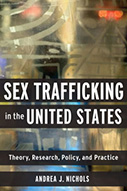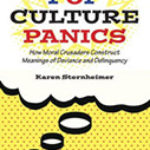Sex Trafficking In The United States: Theory, Research, Policy, And Practice

Author: Andrea J. Nichols
Publisher: New York, NY: Columbia University Press, 2016. 324p.
Reviewer: Corinne Schwarz | July 2017
As human trafficking has emerged as a global human rights concern, anti-trafficking activists and scholars have increasingly been able to access research addressing the complexities and nuances of sex and labor trafficking. Sex Trafficking in the United States: Theory, Research, Policy, and Practice by Andrea J. Nichols provides an introduction to domestic sex trafficking, summarizing many of the current conversations and arguments that shape anti-trafficking efforts. Nichols uses four major theoretical frames: feminist, political, criminological, and sociological perspectives. These theories are used to interrogate a broad range of subjects, including anti-trafficking legislation and policy; risk factors of trafficking; traffickers and criminal networks; purchasers of sex; multi-sector responses to sex trafficking; and activism and advocacy efforts.
Nichols meticulously organizes the text, providing an accessible path for readers with varying levels of knowledge regarding sex trafficking. Each chapter builds on the theories and definitions presented before, culminating in a call to action in the final chapter. At the end of each chapter, Nichols provides discussion questions to assist in synthesizing major themes. This is incredibly useful for both academics seeking to teach the text in a classroom setting, as well as students or individuals outside of academia seeking to understand these concepts. These questions highlight particularly important definitions (such as the legal distinctions between trafficking and other forms of violence); challenging theoretical or moral conversations (such as the power dynamics involved in commercial sex); or personal reflections (such as the reader’s own ideas for outreach programming on sex trafficking identification).
In Part I, Nichols introduces the legislation and definitions of sex trafficking in the United States, focusing primarily on the UN Palermo Protocol and the federal Trafficking Victims Protection Act (TVPA). She also debunks three major misconceptions to explain the legal realities of domestic sex trafficking: sex trafficking is legally not synonymous with smuggling or migrating for sex work; sex trafficking does not require physical restraint or restricted mobility; and sex trafficking legally includes all minors engaged in commercial sex. Nichols addresses the challenges of quantifying sex trafficking and provides data on a range of sex trafficking estimates, using numbers from various government agencies and anti-trafficking non-profit organizations to serve as proxy measures.
The four theoretical frameworks that shape Nichols’s text—feminist, political, criminological, and sociological perspectives—are introduced in Part I, though they are woven throughout the remainder of the text. She summarizes the competing ideologies that shape liberal feminism, radical feminism, and intersectional feminism, paying particular attention to how feminists define agency in these three frameworks. Liberal feminism focuses on the decision-making—or limits thereof—of individual women; radical feminism sees women as a class whose decision-making impacts the broader category of women; and intersectional feminism sees decision-making complicated along lines of gender, race, class, sexual orientation, and ability. Nichols uses neoliberal and abolitionist political theories, which she pairs with the aforementioned liberal and radical feminist theories, respectively. Neoliberal political theories, as Nichols defines them, focus on an individual’s choice to engage in sexual commerce, while abolitionist political theories seek to end all sexual commerce because of its subordination and commodification of women. Sociological theories—those focused on the role of social institutions and inequities—are compared with intersectional feminism. She establishes two primary perspectives for criminology: deterrence theory, which fits with prosecutorial modes of anti-trafficking interventions, and rehabilitation, which is more preventive than reactive. Nichols also spends two chapters discussing pornography and sex work, explaining their contested histories and relationships with sex trafficking. Studies are inconclusive as to whether pornography and sex work have any impact on the prevalence of or attitudes towards sex trafficking, but these are all entangled in the ways commercial sex—and commercial sexual exploitation—are thought of in the United States.
Part II shifts to focus on the individuals affected by and implicated in sex trafficking: trafficked persons, traffickers, and purchasers of sex. Nichols shows the micro and macro-level factors that impact trafficking, from what she calls “identity-based oppression” (p. 84)—factors such as age, gender, sexual orientation, ability, or immigration status that are unique to each person—to the larger social systems and policies that shape institutions, like the education sector or social welfare programs. These trafficking risk factors can accumulate and make individuals vulnerable to the violence and trauma of trafficking—people do not inevitably end up trafficked through their membership in these identity-based categories or through their experiences with flawed social systems.
Importantly, in her discussion of traffickers, Nichols seeks to disrupt the victim/criminal binary that shapes a great deal of anti-sex trafficking efforts. Individuals considered pimps or traffickers have their own set of risk factors for becoming involved in sex trafficking that “are almost identical to that of victimization” (p. 125). Some research even shows that traffickers may have even been trafficked themselves, making the line between their victimization and their own criminalized actions even blurrier. If trafficked persons and traffickers face some of the same individual and structural risk factors, then, Nichols argues, trafficking prevention efforts should address both of these components. This is a fairly provocative claim, especially since many criminal justice-based practices rely upon a clear distinction between a victim of trafficking and a criminal trafficker, and Nichols carefully asks readers to think about how these sometimes-arbitrary distinctions actually play out in individuals’ lived experiences.
In Part III, Nichols introduces the sector-based responses to sex trafficking in the law enforcement, social service, and healthcare systems, as well as activist efforts to raise awareness about sex trafficking. She addresses both the federal, TVPA-based responses to trafficking and the state-level variances. Identification, prosecution, and sentencing are not without challenges, especially when different definitions and perceptions of sex trafficking can create barriers to reporting or identifying cases effectively. Social service and healthcare providers also encounter sex trafficking survivors seeking therapeutic services, medical tests, anti-violence advocacy, shelter, or foster care services. Both sectors face similar barriers to service provision—namely, the challenges of reaching out to trafficked persons without retraumatizing survivors or mischaracterizing the services that can be offered. Nichols offers a range of new perspectives that social service and healthcare providers can utilize to most effectively assist survivors, including trauma-informed care, survivor-defined and survivor-led services, and culturally competent staff. For survivors of trafficking—whose autonomy and agency has been compromised and violated—it is critically important that these sector-based responses do not reproduce the patterns of coercion and control found in trafficking.
Nichols concludes this section with a call to action for readers—“What’s your Green Dot?” She uses the Green Dot campaign, initially used to raise awareness about domestic violence and sexual assault, to frame the interpersonal and societal change that can be effected to increase awareness of human trafficking. She provides an anecdote of her own Green Dot, stopping a young man on the street wearing a “Pimpin’ Hos” shirt to tell him about the damage of this rhetoric. The young man responds positively, turning his shirt inside out and thanking Nichols for making him aware about human trafficking. While this is an example of a direct encounter for creating change, she also offers a range of structural concerns that readers can make their own Green Dot issue, including advocating against social inequalities, contacting legislators, and working with anti-trafficking coalitions.
As stated above, Nichols provides a broad overview of the arguments and ideologies that underpin anti-sex trafficking scholarship and activism. Because she chooses four theoretical frames, the arguments and ideologies presented tend to fall in line with these stances. These frameworks provide readers with a solid foundation to begin to understand the interdisciplinary approaches needed in the field of human trafficking research. Readers will be in a better position to understand and analyze the parallel conversations across a range of other disciplines—for example, anthropology, political science (beyond neoliberal or abolitionist theories), and sociolegal studies, to name only a few academic fields producing anti-trafficking scholarship.
Additionally, human trafficking is a complex, contested terrain of research, both theoretically and empirically. Nichols addresses these concerns—notably in her discussion of traffickers—but the generalizations inherent to an introductory text sometimes elide the nuances that exist in sex trafficking scholarship. For example, Nicholas frames many conflicting viewpoints in binaries, such as the neoliberal emphasis on individual agency versus the abolitionist approach of collective empowerment (or disempowerment). These arguments frequently play out in a binary, “us versus them” manner, and readers will benefit from unpacking them as they advance in their study of human trafficking to understand the nuances and overlaps between these theories. Nichols does not position herself in these binaries so that readers may make up their own minds about these complex debates. Since this text is designed for introductory purposes, readers will need to delve deeper into the vast range of anti-trafficking perspectives. For those well versed in these conversations—regardless of where they may fall on the ideological spectrum—this framing is sometimes vague, especially when the nuances of these arguments are necessarily truncated for readers new to the field.
Nichols has written a solid, well-constructed analysis that taps into current academic and activist conversations about sex trafficking. Sex Trafficking in the United States: Theory, Research, Policy, and Practice is an accessible, engaging text that establishes the parameters for these conversations and efforts, while also concluding with a call for more expansive, creative, thoughtful anti-trafficking practices. Nichols offers an impressive scope of subjects, ranging from the micro-level of individual survivors’ unique experiences to the macro-level policy that shapes anti-trafficking efforts and perpetuates precarity for vulnerable persons. This text is perfect for classroom use, especially for introducing students to the complexities of domestic sex trafficking, as well as for anti-trafficking stakeholders invested in on the ground advocacy and service provision.


